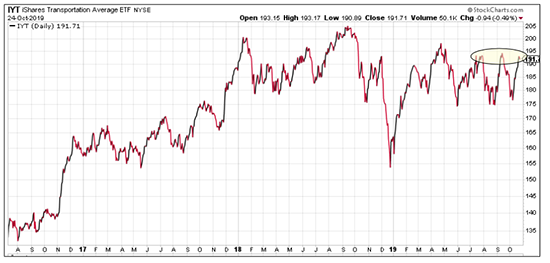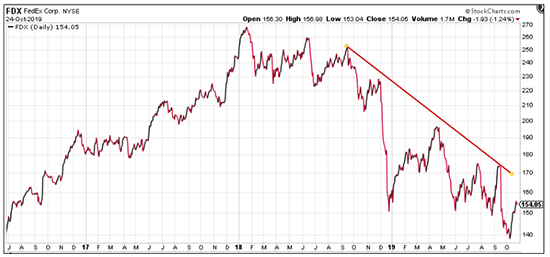Buying Puts on Transport Stocks as a Protective Hedge
The U.S. stock market is in an uncertain place right now. The Dow and S&P 500 are not far from their all-time highs, but technology stocks are a mixed bag and small caps are well off their highs.
Then, too, economic indicators are also a mixed bag. Some point toward optimism, but others are more gloomy, or even ominous. And there is no shortage of political and geopolitical drama: Brexit, trade war, Middle East saber rattling, impeachment fights, on and on.
In such an environment, a bearish position can be useful as a hedge against long equity exposure.
If you are net long stocks, you can do well if the market goes higher, but you are also exposed to downside risk. Adding a bearish position to a net long portfolio can reduce some of that risk, because the bearish position is likely to make money if stocks take a tumble.
But what to be bearish on? You always want to put odds and probability in your favor, whether looking to the bull or bear side. One bearish industry candidate is transports, which have been struggling.
We can see this by looking at IYT, the iShares Transportation Average ETF. This group of stocks has more or less stayed in a wide sideways range — apart from the sharp drop and steep rebound in December — for almost two years.
As of this writing, IYT is back near the top of a multi-month range, close to a point of well-established overhead resistance. If the general pattern holds — and especially if markets turn bearish — IYT is a candidate to reverse within its range and head lower again.
 |
So, one possible way to hedge long portfolio risk is implementing a “bear market protection strategy” by shorting IYT, or alternatively buying puts on IYT.
There is a reasonable probability IYT will stall out and reverse — and if another round of bad economic news comes in, the outlook for transports will deteriorate, and IYT could start a new downtrend.
The protection aspect comes from having long exposure in your portfolio. If you are net long, adding a bearish position helps reduce that long side market risk. If you aren’t net long, that is fine, of course, but then it is a speculative position rather than a protective hedge.
It’s also possible to improve on this idea by looking at the transport components within IYT. An ETF like IYT usually represents a basket of stocks, some of which are stronger and some of which are weaker.
Over the past 12 months, IYT’s worst performing component by a large margin is FedEx (FDX). FedEx is down about 28% over the past year, in part due to competitive pressure from Amazon.
FedEx is in a clear downtrend as you can see below. But the stock has also seen a rebound over the past two weeks. That rebound could be useful for a short entry, perhaps via put options.
 |
The presence of an ongoing downtrend — which shows investors are already selling — makes FedEx a potentially more attractive bearish candidate than IYT, which is still rangebound.
That is because, as a general rule, you don’t want to be early when entering a position. You want to find a reasonably attractive entry point in a move that is already underway, but still has room to run. FDX satisfies both of these conditions.
Within the basket of stocks that make up IYT, there are other names besides FDX that are notably strong or weak. Airlines components are on the weak side, for example, while railroads are looking healthy.
This poses a natural question: If the bearish transport play is expanded, why not lean toward puts on the weaker airline stocks, while avoiding the stronger railroads? If IYT does fall in price, the weaker components may fall even harder (as investors telegraph less interest in buying them).
We can do this on a repeat basis: Find an ETF with attractive positioning — relative to a combination of price action, the fundamental picture, investor sentiment, and total portfolio exposure — and then drill down into the ETF to buy the strongest components (or conversely buy puts on the weakest).
And coming soon, we’ll start expressing our best trading and investing ideas in a model portfolio — while taking your questions via e-mailbag!
TradeSmith Research Team